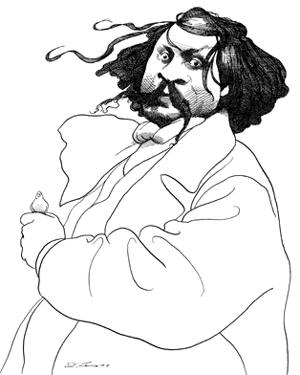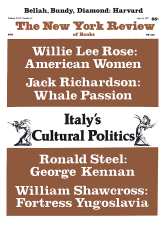Everyone who has dabbled in the lives of Balzac, Baudelaire, Sainte-Beuve, Flaubert, George Sand, Zola, or almost any minor or major celebrity of the French nineteenth century has taken his view of their personal appearance from the photographs, constantly reproduced, by Nadar. And possibly without knowing that this Bohemian genius was one of the dramatic princes of photography during his long life. Our ignorance is now remedied by Nigel Gosling in a lavish, exhaustive, and very well written book which contains not only scores of Nadar’s portraits, long essays on his life, on his diverting character, and on his work with the camera and in the darkroom, but—since the nature of his sitters meant everything to him—also short and witty comments on their careers. Post-1830 Paris comes to life, Gosling’s scholarship is telling and delightful, and his book is one of the very few works on photography with a knowledgeable text that is quite distinct from the merely decorative letter-press in tasty prose that we are usually given.
Nadar’s talent was exceptional because it grew out of a scientific and technical inventiveness which was fertilized morally by a romantic and radical temperament; as a man, he was rooted in Mürger’s Vie de Bohème, as a professional, in printing, journalism, the drawing of cartoons, and in the theater. In the great century of novelists, playwrights, and scribblers, he became, so to say, a dramatic novelist whose pen was the camera.
Nadar was a bluff red-haired giant with blue eyes whose real name was Tournachon. He was the son of a successful radical printer who had moved his business from Lyon to Paris. The father’s politics were against him, the business went downhill—one remembers the troubles of bankrupt French printers from Balzac’s life and novels in the same period—and the son turned to the feverish semi-starvation of journalism. The revolution of 1848 woke him up politically (he said) and romantically he joined the Polish Legion to rescue Poland from oppression. The venture came to nothing, and he returned to satirical journalism and, having a gift for caricature, went to work in London, which at that time had the finest caricaturists in Europe. There he met Constantin Guys and Doré, and when he returned to Paris he formed the idea of publishing a collection or Pantheon of celebrities for Le Journal Amusant: it was to be called “La Lanterne Magique.” It contained sketches of Doré, Rossini, Meyerbeer, Berlioz, Delacroix, Hugo, and others. He then brought his enormous energies, intelligence, his inventiveness and bursting good nature, almost by chance, to photography in 1853.
The technique which Nadar learned was a new process invented by an Englishman, F. Scott Archer. It was called the “wet plate” technique, and involved coating a glass sheet with collodion, and sensitizing it in a solution of silver nitrate. While the mixture was still wet the plate was exposed to the light in the camera; on the parts most affected by the light the silver (as any housewife would expect) turned black. The wet plate was then rapidly developed, producing a sharp negative which could be printed onto ordinary writing paper, prepared with a coating of white of egg, to which salt and silver nitrate had been added. (After 1861 he used the easier dry collodion process).
The process was smelly and dangerous: cyanide and nitric acid were used. As for the sitter, he had to sit motionless for several minutes while the photographer paced up and down counting the seconds aloud and chatting fast to keep him relaxed. One of the few remarks Nadar made about his sitters was that the wives always looked first at the photographs of their husbands, while the husbands looked first at themselves. Soldiers and actors were the vainest of the models. But he did not confine himself to people. Experimenting with artificial light, he carried a mass of equipment and cables into the sewers of Paris and produced almost surrealist pictures which, in one way, are the most delightful things in this book. Sewers don’t mind how long they sit!
Nadar’s grand studio in a building painted red in the Boulevard des Capucines was ornate and crowded with “properties.” The taking of a photograph was often a crowded social occasion. When we look at the faces of the sitters, we are often struck by their melancholy and brooding look. Is the bourgeois embedded in the financial worries of progress and materialism? In an age of overeating are they all suffering from indigestion? Are they satiated? Or psychosomatically ill? The Goncourts noted at a sale of Nadar’s work later, “Everything has become black in this century’s photographs: photographs are the black clothing of things.” (In England, Lewis Carroll’s young girls seem rather puffy and unwell.) At a second look our impression changes. The rewards of the long sitting seem much greater than those of the click-click-click of the hit-or-miss modern photographer. The longer Nadar takes the more certainly the sitter surrenders to his real nature, the more deeply—or wittily—Nadar penetrates the physical and moral character. He sought what the Romantics valued: the force, the dynamic, the ruling passion of the sitter’s temperament. And, even in the tired, the gentle, the resigned, or the defeated, he saw that tiredness, gentleness, and resignation were forces also. These people have lived.
Advertisement
In short, the one-time caricaturist had become a novelist. So, of Louis François Veuillot, the violent right-wing Catholic pamphleteer and duelist, the son of a cooper, someone said he looked like “a poisonous mushroom”; but Nadar, who hated Veuillot’s views, nevertheless catches the old brute in a mood that is almost sympathetic: Nadar could not help responding to the kinship of nature even in his enemies. It says much about his character that he was always a close friend of Baudelaire, who admired him, though he wrote fiercely against the evil influence of photography in his art criticism. (The fine portrait of Baudelaire is well-known.) He cared for the broken Constantin Guys even though he found his old soldier’s manners insupportable.
Nadar catches the sly juiciness in the disturbed but genial face of Rossini and the disarray of the impeccable Gautier; the woolly hair and hot aplomb in Dumas père and the cool eye for publicity in the son. The Delacroix is severely aristocratic; the sensibility is there but also the haggard look. The Guizot is a surprise, for Nadar sees the austere, upright man inside the premier who preached the humdrum religion of the middle class—which Balzac’s Vautrin read in another sense—“Get rich through work and saving.” (Hugo said Guizot gave the impression of an honest woman running a brothel.)
One can almost tell from the carriage and the cold direct eyes of the forgotten dramatist Legouvé that he was a firstclass shot who never fought a duel: no one would have dared to challenge a man with eyes that look like pistols. Nadar’s Jean Journet is the uncouth, rugged, theatrical evangelist with eyes raised to heaven, but it is typical of Nadar as a feeling man that he could write, “I felt a kind of naturalist’s curiosity about the admirable obstinacy which never left him for a second during the thirty years of his impossible struggle.”
The Sainte-Beuve, Bakunin, Michelet, Berlioz, and George Sand have often been reproduced. The young Sarah Bernhardt is ravishing—she must have been one of the few slender young women of the time, outside the starving. The women, from the respectable to the admired girls of the Folies Bergères, were bulky in rump, breast, belly, and thighs and their clothes doubled the strange seduction. There are shocks for every reader here: we knew that the composers of operas would look like rich industrialists, for opera made its millionaires; but we do not expect Debussy to look like a well-dressed stockbroker giving a discreet tip on the Bourse.
Nadar loved celebrity for its own sake of course; but his radical beliefs were sincere if woolly. He was drawn to George Sand not only because of her fame and her monumental figure, but by her communism. She even wrote a preface to his book Le Droit au Vol—nothing to do with Proudhon’s idea that property was theft, but with man’s right to a heavier-than-air flying machine. For, partly from a love of inventions and an eye for publicity, Nadar became passionately interested in ballooning and organized a balloon flight for thirteen passengers. The thing was appropriately called Le Géant. On a second flight to Hanover he scattered the then banned copies of Hugo’s Les Châtiments over Paris. Nadar had seen the military use of aerial photography and in 1870 he left Paris in a balloon during the siege through a shower of German bullets and reached Normandy from where he sent an appeal for help to the London Times. He had established the world’s first air mail! Not bad for a photographer.
Nadar was almost ninety when he died. His wife to whom he had been married for fifty years was dead. She had been an invalid for years and he had nursed her lovingly; but he was a domineering man who had quarreled with his brother and his son Paul, who carried on the business in the new style and became the agent of Eastman-Kodak. Mr. Gosling offers a large number of portraits that came from the studio after the father’s death, and it must be said that they make a smooth, efficient, and machined impression very different from the father’s work, though by now everyone famous in Europe went there to be photographed, from tsars and kings downward, well into the new century. (There is a reviving final picture of Réjane’s little daughter, dressed up to look like a child Napoleon.)
Advertisement
In old age Nadar still looked like a wondering schoolboy with white hair. He called himself “superficial…a jack of all trades who smiles out of one corner of his mouth and snarls with the other…never one to miss the chance to talk of rope in the house of a hanged man.” Flamboyant, exuberant, anticlerical, antiracialist, antisnob, he was, as Mr. Gosling says, a perfect example of the nineteenth-century progressive—energetic, optimistic, practical, an individualist and a patriot whose “beloved socialism” was tremendously vague but totally sincere.
This Issue
July 14, 1977




